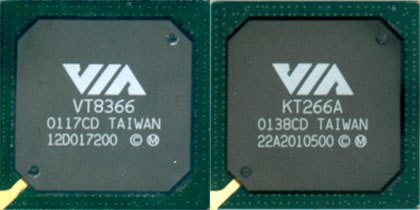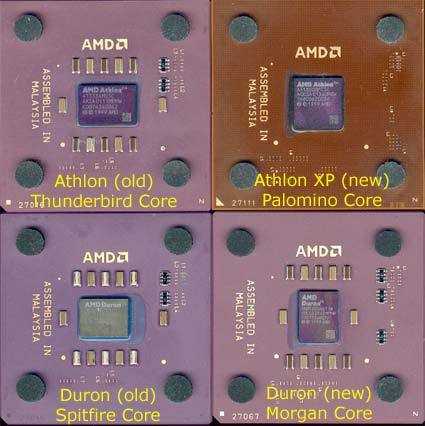Mega Test: 14 Boards with KT266A and nForce 420D
VIA Changes Their Naming Convention
Good bye old cryptic VT... something. The old KT266 northbridge is still known under VT8366 whereas the new baby KT266A is also called KT266A.
Four CPU types for socket A are available. All of them are now supported by KT266A and nForce 420D.
Comparing The Chipsets - VIA Vs. Nvidia
| Chipset | VIA Apollo KT266A | VIA Apollo KT266 | Nvidia nForce |
|---|---|---|---|
| Introduction | September 2001 | April 2001 | September 2001 |
| Platform | Socket 462 | Socket 462 | Socket 462 |
| Supported processors | AMD Duron/Athlon/XP | AMD Duron/Athlon/XP | AMD Duron/Athlon/XP |
| Multi-processor support | no | no | no |
| Northbridge | VIA KT266A | VIA VT8366 | Nvidia IGP 128 |
| Southbridge | VIA VT8233 | VIA VT8233 | Nvidia MCP-D |
| Front Side Bus clock | 100/133 MHz DDR | 100/133 MHz DDR | 100/133 MHz DDR |
| Memory clock | 100/133 MHz DDR | 100/133 MHz DDR | 100/133 MHz DDR |
| Asynchronous memory clock | yes | yes | yes |
| FSB overclocking* | up to 200 MHz | up to 200 MHz | up to 150 MHz |
| Max. # DIMM slots | 4 | 4 | 3 |
| Max. memory | 3072 MB | 3072 MB | 4096 MB |
| SDRAM support | yes | yes | no |
| DDR SDRAM support | yes | yes | yes |
| Dual-channel DDR support | no | no | yes |
| RIMM support (Rambus) | no | no | no |
| Ultra-DMA/33/66/100 | yes/yes/yes | yes/yes/yes | yes/yes/yes |
| # USB connectors | 6 | 6 | 6 |
| Max. # PCI slots | 6 | 6 | 6 |
| integrated graphics core | no | no | yes |
| integrated sound | yes | yes | yes |
| AGP 1x / 2x / 4x | yes/yes/yes | yes/yes/yes | yes/yes/yes |
| ACPI supported | yes | yes | yes |
* depends on clock generator
UltraATA/133
Some manufacturers are gradually updating their KT266A based products, as there is one controller with ATA/133 support already available: HighPoint's HPT372. It is pretty much the same chip than the HPT370 ATA/100 RAID controller, supporting RAID modes 0, 1, 0+1 and JBOD (spanning). Of course you can also attach any other ATA drive without any RAIDing. Just be careful with CD-ROM drives, DVD ROMs or writers: All of them use the ATAPI interface which is not supported by most IDE RAID controller chips.
More About The nForce - 128 Bit Memory Bus
One of the main characteristics setting the nForce chipset apart from the VIA KT266A is its dual-channel DDR SDRAM interface. This means that two 64 bit DIMM modules are merged to create a 128 bit wide memory bus.
But there are a few snags: The Nvidia chipset will only reach peak performance with two identical RAM modules. If, however, a third RAM module is added to the fray, the dual-channel mode, with its 128 bits of bandwidth, is automatically deactivated. That fact alone makes upgrading RAM tricky at best, pumping up the price as well.
What's more, there's no way to determine which mode the board is running. Asus is planning to address the problem by integrating a special display feature in future BIOS versions.
Get Tom's Hardware's best news and in-depth reviews, straight to your inbox.
The graphics integrated into the board are derived from the GeForce2 MX, which addresses memory according to the shared-memory system. All told, up to 64 MB RAM can be reserved for graphics functions.
Current page: VIA Changes Their Naming Convention
Prev Page Chipset Duel - VIA Vs. Nvidia Next Page 12 Boards With VIA KT266A - Fastest Chipset For AMD & Duron
